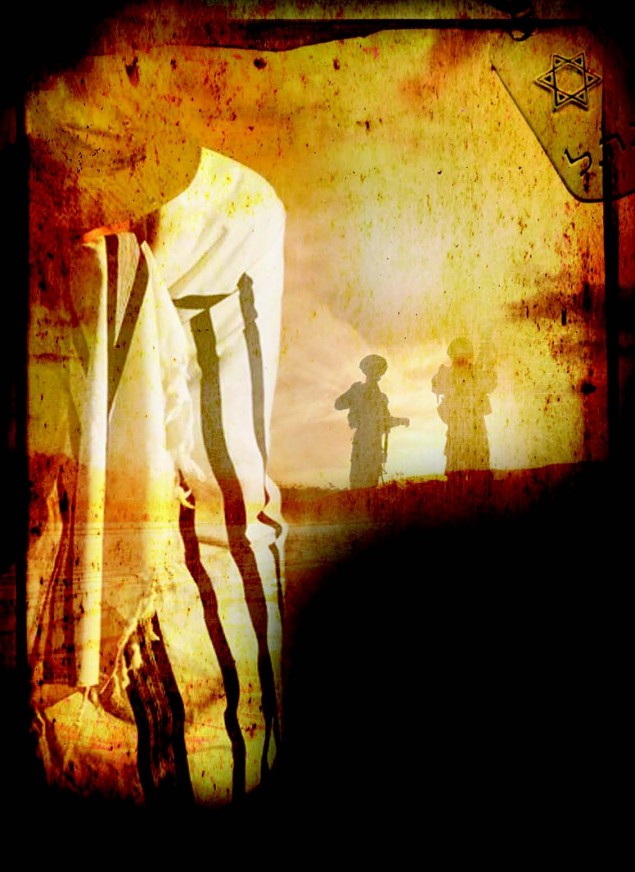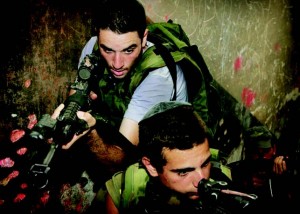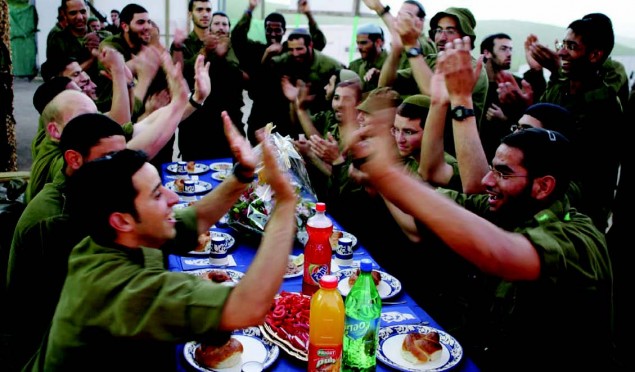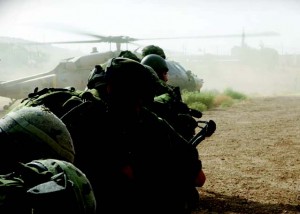Nahal Haredi Comes of Age
 As our Jeep bounces violently through a valley somewhere in the Jordan Valley, we spot a group of about fifteen khaki-clad soldiers on a nearby hill. The soldiers have been stationed on the hill for the last five days while conducting various training exercises. We arrive just before the start of a live ammunition drill; this group must fire smoke bombs in the direction of some nearby hills, where a large number of troops are simulating the capture of an enemy stronghold.
As our Jeep bounces violently through a valley somewhere in the Jordan Valley, we spot a group of about fifteen khaki-clad soldiers on a nearby hill. The soldiers have been stationed on the hill for the last five days while conducting various training exercises. We arrive just before the start of a live ammunition drill; this group must fire smoke bombs in the direction of some nearby hills, where a large number of troops are simulating the capture of an enemy stronghold.
The soldiers in the group are all members of the Israel Defense Forces (IDF) Nahal Haredi battalion, and I’m visiting them in the field. My guide, Rabbi Yitzchok Bar Chaim, was one of the moving forces behind the establishment of Nahal Haredi. For him, live ammunition drills are old hat. Every other day, he travels over an hour from Jerusalem to one of the five bases where Nahal Haredi soldiers are stationed– three in the Jenin sector and two in the Jordan Valley–or to one of the training courses in which they are participating.
Rabbi Bar Chaim is received warmly as he exits the Jeep. Although there are more than 900 young men currently in Nahal Haredi, he greets most of the members of the unit by name, and they are clearly happy to see him. While waiting for the live ammunition drill to begin, he calls the group together for an impromptu shiur on the week’s Torah reading, Chaye Sarah. Everyone joins, and there is soon a lively back and forth of questions and answers. The degree of participation would be the envy of many teachers in a more conventional classroom setting. In the course of the discussion, a number of young men pull Chumashim from their backpacks that contain everything they will need for their week in the field.
The Birth of Nahal Haredi
Nahal Haredi began a little over a decade ago, after about a year and a half of ongoing discussions between a group of Chareidi educators led by Rabbi Bar Chaim and the IDF. At the time, Rabbi Bar Chaim was working with Chareidi youth who were falling between the cracks of the yeshivah system.
The phenomenon of such youth, whose ranks were already swelling at an accelerating rate, reflects larger social processes within the Chareidi world. In the 1950s, in Bnei Brak there were less than 100 families of traditional Lithuanian yeshivah stock. From their ranks were drawn most of the idealists who answered the Chazon Ish’s call to rebuild the vibrant Torah life of pre-war Europe. That small flock of intense idealists, willing to adopt the simplest standard of living in order to pursue full-time learning, has today swelled, against all odds and all predictions, to a community of nearly threequarters of a million souls.
Today’s larger community is not just the original group of intense idealists writ large, but something much different. It includes individuals of all spiritual and intellectual levels. The standards that could be followed by a small flock of intensely committed idealists cannot be successfully imposed on such a large community. The attempt to do so has resulted in many casualties including numerous yeshivah bachurim in their teens or early twenties who do not derive sufficient satisfaction from their Talmud learning to spend their entire day in yeshivah. At the same time, they are effectively barred from gainful employment by their lack of army service and, in most cases, any marketable skills.
Rabbi Bar Chaim wondered whether the IDF might be a solution for many of these young men. The initial response from the IDF was positive. The IDF was represented mainly by General Yehuda Duvdevani, then the head of the Defense Ministry’s Department of Youth Activities and National Vision. The IDF agreed to treat a third year of study–either spent obtaining a high school equivalency certificate or some form of vocational training–as fulfilling the third year of the national service requirement.
Netzah Yehuda, a non-profit organization, was created to serve as the official liaison to the IDF and the Defense Ministry. The organization is responsible for everything connected to the spiritual development of the Nahal Haredi recruits: supplying the rabbis who give Torah classes to the troops; providing Rosh Chodesh gatherings; assisting Nahal Haredi soldiers in dire financial circumstances, and recruiting new soldiers. Rabbi Bar Chaim and his partner, Rabbi Dovid Fuchs, field dozens of phone calls every day.
Relations between Netzah Yehuda and the IDF have generally been excellent. All the food is glatt kosher, with recognized Chareidi hechsherim; the rabbis of Netzah Yehuda work closely with the battalion rabbi to minimize chillul Shabbat not connected to actual combat; and no women soldiers are found at the Nahal Haredi base.
Netzah Yehuda has proven crucial to the development of the Nahal Haredi. To become a full combat unit, for instance, the initial Nahal Haredi battalion needed medics attached to the unit. But since many of the training drills in the medic course involve simulating situations in which the “wounded” are largely undressed, it was necessary to arrange for a complete separation between the all-male course, in which the Nahal Haredi soldiers trained, and those in which the trainers were mostly young women soldiers. After a great deal of investigative legwork, Netzah Yehuda was able to make suitable arrangements with
the IDF.
Upon occasion, Netzah Yehuda has raised private monies to supply equipment that the IDF could not afford for the battalion members. Its executive director, Rabbi Tzvi Klebanow, is currently working on the final draft of an IDF handbook of policy and procedures concerning the Nahal Haredi to ensure continuity in the face of the rapid turnover of IDF personnel.
Communal Opposition
When Nahal Haredi was first introduced a decade ago, it encountered fierce opposition within the Chareidi community replete with the usual wall posters and demonstrations. Even Mishpacha, considered one of the most progressive of the Chareidi weekly publications, printed a lengthy attack on Nahal Haredi. So intense was opposition to Nahal Haredi in Meah Shearim that Rabbi Yoel Schwartz, one of the original backers, eventually had to leave his apartment there. At the same time, Nahal Haredi enjoyed the tacit support of some of the major Torah leaders of the Chareidi community, who recognized the need for an alternative for young men who had left the yeshivah system altogether.
Underlying much of the opposition to Nahal Haredi was the fear that the opportunity to serve in the IDF would result in a mass exit from the yeshivot. Those fears proved unfounded. Nahal Haredi has not resulted in a complete about-face in Chareidi attitudes towards army service. Even today, only a handful of those from Chareidi backgrounds in each recruiting class opt for army service out of an idealistic desire to contribute to the defense of the Jews of Israel. That idealistic commitment develops with service–usually quickly–but does not precede it.
Nahal Haredi neither triggered a large-scale exodus from the yeshivot nor prevented the development of a whole network of yeshivot dealing with those who experienced failure in the mainstream system. As a consequence the opposition to it has also withered away.
Development of Nahal Haredi
Nahal Haredi has grown dramatically from the first group of thirty soldiers and changed in a number of other important ways. The last recruiting class of 180 was the largest yet. (The IDF inducts new recruits three times a year.) As of this writing, more than 2,000 young men have completed Nahal Haredi.
Though the original impetus for Nahal Haredi was the problem of drop-out Chareidi youth, relatively early on the decision was made to also take recruits from the National Religious world who prefer the stricter religious standards of Nahal Haredi. Those recruits drawn from the “Chardal” (Chareidi Dati Leumi) community comprise about 30 percent of Nahal Haredi, a limit strictly enforced by the IDF. The rest of the recruits (with the exception of a little more than 10 percent who come from abroad and serve a shorter time) tend to have spent time enrolled in various Israeli Chareidi educational frame works, including Chabad and those for the newly religious.
The recruits from Chardal homes are, in many respects, coming from the opposite direction from their Chareidi counterparts. Most of them have grown up with a strong ethos of IDF service. And far from struggling with religious observance, they are seeking a level of observance often higher than that of the communities from which they come. Yet by all accounts the combination has worked out well. Nahal Haredi has become the venue for the closest interaction between those from Chareidi and those from National Religious backgrounds.
Another crucial change over the last ten years has been the transformation of Nahal Haredi to a full-fledged combat unit. General Udi Shani, the former commander of the division of which Nahal Haredi is a part, describes Nahal Haredi as “the nekudat ha’or, the point of light” of his division. Though non-religious, Shani once told a group of American visitors, “We understand that the combination of Torah, tefillah and soldiering experience combines to produce an invincible soldier.”
Nearly every day of the week, around 5:00 PM, a Nahal Haredi unit begins preparing for an early morning raid to nab terrorists in Jenin. Those who will be participating begin laying out their equipment, usually totaling fifty pounds or more. They then are briefed on the mission and practice their plan of execution. Around 3:00 AM, the unit will sweep into Jenin in an armored personnel carrier. Usually within a few minutes, they succeed in capturing the wanted terrorist.
One soldier from Australia, proudly sporting his newly affixed sergeant stripes, told me that he has seen more action than the average unit stationed on Israel’s northern or southern border. “They are basically sitting and waiting for something to happen. I can go night after night arresting terrorists in their beds in Jenin.”
The development of Nahal Haredi into an active combat unit has increased the quality of recruits. It took time for Nahal Haredi to prove its military prowess to skeptical commanders, and as a consequence the initial assignments ten years ago were lower on the IDF totem poll. The increased prestige of Nahal Haredi as a serious combat unit has made it more attractive to young men from Chareidi backgrounds eager to prove themselves, sometimes after years of being made to feel like failures.
Certain slow but clearly discernible changes in the attitude of the Chareidi world towards the IDF have also made it somewhat easier to attract recruits from traditional Chareidi backgrounds. In the last couple of years, the IDF has become a major employer within the Chareidi world. Over 500 young men, many of them married kollel students, have enlisted in training programs in computers, quality assurance, airplane maintenance and intelligence. This group currently has the highest rate of sign-up for officer training courses of any group within the army.
While the trade-off is largely pragmatic– the IDF is provided with a large pool of talent to draw from and the Chareidim are provided with training in highly sought after fields–the result is that it is no longer rare in Chareidi strongholds, like Bnei Brak or Kiryat Sefer, to see young men who, a few months ago, were respected kollel avreichim now wearing IDF uniforms. That makes it much easier for younger Chareidi recruits to contemplate enlisting.
Impact on the Chareidi Community
What has been the impact of Nahal Haredi on those recruits from Chareidi backgrounds who were already far removed from most mitzvah observance by the time that they enlisted?
Nahal Haredi addresses this problem in two ways. The first might be called “turn from evil.” The hermetic environment of Nahal Haredi removes the recruits from an environment in which a host of temptations were constantly before them. The second is to provide them with the emotional tools to sustain a life of mitzvah observance again. Early on, one of the gedolim who advises Nahal Haredi enunciated its goals for the soldiers from Chareidi homes currently alienated from religious observance: First be a mensch, then a tzaddik.
The IDF provides these young men, who have in most cases been doing nothing with their lives after dropping out of yeshivah, with the discipline and ability to take responsibility for their lives. Rabbi Dovid Bloch, one of the rabbis on the rabbinic board of Netzah Yehuda, insists that there have been very few recruits who were not transformed for the better on the scale of menschlichkeit in the course of their army service.
Becoming a mensch makes possible the return to religious observance, sometimes even to the beit midrash, but there is nothing automatic about that return. Many of the Chareidi recruits bear heavy scars and feelings of failure and rejection, which they associate with their religious upbringing.
Rabbi Bloch observes that in those Chareidi families in which the parents take an interest in what their sons are doing in the IDF and do not show embarrassment about their service, the percentage of those who return to full religious observance is very high. In short, the army can help break the bad habits that develop once a boy drops out of the yeshivah system and can give him back his self-respect, but the IDF cannot cure the bitterness of rejection by family and community. Only the family and community can do that.
Prior to their IDF service, few of the boys from Chareidi backgrounds were employable in anything but the most menial jobs. But what they gain in discipline and responsibility in the IDF, in conjunction with their third year of academic or vocational studies, enables them to enter the workforce on an equal footing. Recently, the Jerusalem Post reported that almost 100 percent of those who completed the three years of Nahal Haredi service are currently employed.
Impact on the Secular-Religious Divide
One major new development in Nahal Haredi has immense long-range implications. In response to a petition from former Nahal Haredi soldiers, the IDF has responded affirmatively to the request for a Nahal Haredi reserve battalion. Until now, Nahal Haredi graduates were freed from reserve duty because of the lack of a suitable framework within the IDF for a largenumber of Chareidi soldiers. Now, it would appear, the army is prepared to work towards creating such a framework for a much larger number of soldiers than previously.
That represents a crucial step. The issue of the Chareidi community’s failure to share in the burden of army service is poised to explode. So long as Chareidim were a small percentage of the country, their non-service did not undermine the IDF’s ability to serve as a source of social cohesion.
But the Chareidi community is growing rapidly. Over the last decade, enrollment in Chareidi primary schools increased 49 percent, while enrollment in the government system dropped 1 percent. Within a generation, Chareidim will constitute 30 percent of the draft cohort, and together with Israeli Arabs, who also rarely serve in the army, over 50 percent. If less than 50 percent of the citizenry serves, the IDF can no longer provide any degree of social glue in a society already beset by among the highest disparities of income in the Western world. Nor will non-Chareidim continue to serve under those circumstances. As the head of one of Israel’s leading think tanks recently told a Chareidi Knesset member: “My children will not be your children’s mercenaries.”
By providing the catalyst for the creation of frameworks in which much larger numbers of Chareidim can serve without compromising their religious standards, Nahal Haredi may have pointed the way to defusing a ticking societal time bomb.
Jonathan Rosenblum is a columnist for the Jerusalem Post and Israeli director of Am Echad.



